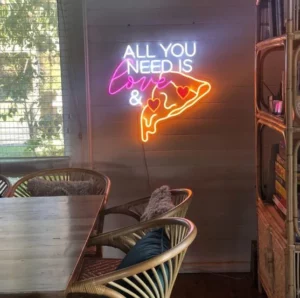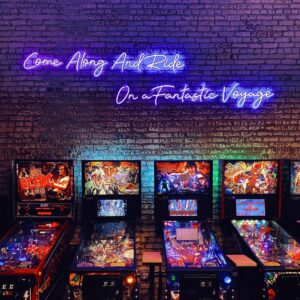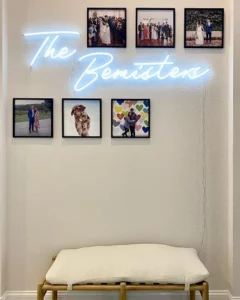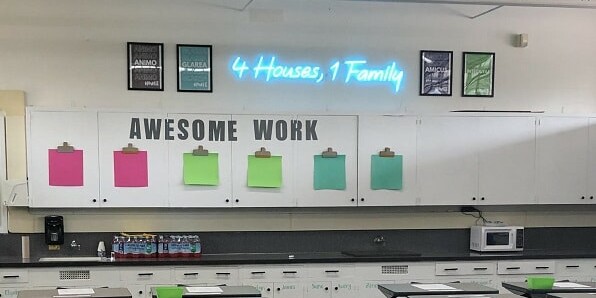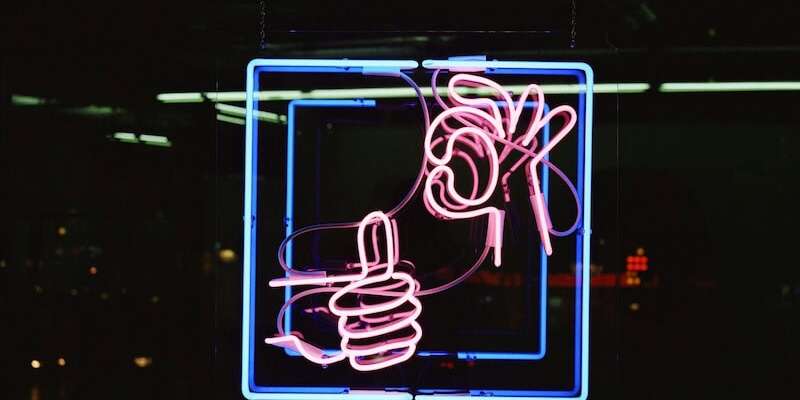Neon signs are one of the unique instruments of advertising used globally. Because their bright and colorful glow helps in drawing people’s attention, they can be used by any business in any industry. The first neon sign was made over a century ago, which means it has passed through several technological advancements. Therefore, as neon signs become more popular, they also continue to evolve.
In this article, we will look into the origin of neon signs, how neon light signs were created, and how they have evolved over the years.

Origin of Neon Signs
To understand the evolution of neon signs, we will take a quick journey to the origin of neon signs and evaluate the subsequent technological advancements that follow.
The Glow From The Mercury Barometer
In the mid-17th century, a French astronomer named Jean Picard discovered a faint light glow in a mercury barometer. He realized that whenever he shakes this barometer, the glow will come up. It was a significant observation because it was the first time anyone observed a glow in a vacuum tube. However, he didn’t know what exactly caused this to happen but it formed the baseline for the study of electricity and the development of vacuum tubes that relies on electric discharge in gases. As time goes on, scientists invented electricity and they went on to research what could cause a glow in a barometric tube.
In 1676, a Dutch Physicist named Peter van Musschenbroek found a breakthrough in the reason for the faint light glow, and he realized that the glow was a result of an electric discharge that occurred when mercury was exposed to a high voltage.
Heinrich Geissler and His Geissler Tube
In the 19th century, a German Physicist named Heinrich Geissler was interested in how mercury, when exposed to high voltage, can cause a glow. He then decided to try if other gases when exposed to high voltage and low pressure will produce this result. He achieved this by inventing a tube, which was named after him as the Geissler tube.
He experimented using different gases such as hydrogen, nitrogen, carbon dioxide, oxygen, helium, etc. He discovered that when a high voltage is applied across the electrodes at the end of the tube containing these gases, these gases glow. This led to the invention of vapor lamps in the United States and Europe, thereby laying the foundation for products such as neon tube lamp and LED filament lamp today.
The Birth of Liquefied Neon Gas
In 1898, two British scientists, Morris. W. Travis and Ramson Williams discovered three new gases, Neon, Krypton and Xenon when they were conducting experiments on liquefying air. Before that, Neon has been known to only exist in the atmosphere. They realized that it could be extracted by liquefying the air and separating it from other gases by fractional distillation. They named this gas neon, which is derived from the Greek word neos, meaning new gas.
The First Neon Light Produced
In 1902, a French Engineer named George Claude discovered that when an electric current was passed through a gas, it would emit a colored light. He then decided to produce a light by using neon gas. He discovered that when he passed an electric current through the neon gas, it emitted a bright red light.
In 1910, George Claude enclosed a neon gas in a sealed glass tube and passed an electric current through it. This produced a bright glowing light that could be seen from a distance. He decided to turn this into a lamp. This was the first neon light that was ever produced.
How Were Neon Light Signs Created?
George Claude went ahead to invent a method by which glass tubes could be designed into different shapes, which led to the creation of the first neon gas signs. This caused a revolution in the advertising industry as the new invention gained popularity globally.
In 1913, a French engineer, named Jacques Risler, upgraded the neon signs by adding more gases to the tube to generate more colors. For example, the neon gas will give off red or orange colors when electricity is passed through its tube. Pure Xenon produced white. Argon gave off a green color. A combination of Argon and Helium will give a golden fluorescence in the glass tube. When Argon is combined with Xenon, they will both give pink color. Mercury produced a blue light color, while Krypton gave grey light.
In essence, over the years, people have learnt to combine various noble gases to produce the neon sign lights they desire.
The Evolution of Neon Signs
In the early days of neon signs, the invention faced some challenges. Some of the challenges included the fact that the neon gas was difficult to contain and the tubes were made by hand. However, in the 1920s, there was advancement in glassblowing techniques that improved the production of glass tubes and made it easier to create more neon signs and even complex ones.
As the years went by, neon signs started to become more and more popular. Cities like New York, Las Vegas, and Chicago started becoming famous for their bright neon lights and signs. The way these signs were displayed looks so colorful and welcoming. Interestingly, some of the neon light signs that were created as far back then are still in use today. An example of this is the sign on the Las Vegas Strip that reads “Welcome to Fabulous Las Vegas.”
Indeed, technological advancement has also played a major role in the evolution of neon signs. For example, manufacturers have eventually adopted plastic tubes in place of glass tubes, making neon signs more durable and easier to transport. The invention of plastic tubes also created room for even more complex and more creative neon lights that improved the advertising industry.
Advantages of LED Neon Lights Over Conventional Neon Lights
In our world today, LED neon lights have progressively replaced the traditional neon lights. Compared with the traditional neon lights, LED neon lights use flexible plastic tubes that can be shaped into numbers, letters, and other forms of designs.
Some of the advantages of LED neon signs over the traditional neon lights are that they are more durable, easier to maintain, and more energy-efficient. Moreover, they come with a wider range of colors that can be programmed to flash lights of different colors, which are more attractive than what was obtainable with traditional neon lights.
Contemporary Uses and Design Trends
Over the years, neon lights have continued to evolve with advancement in technology and changes in design trends. Although they have been in existence as far back as the early 20th century, they continue to remain relevant in this contemporary world. Their glow and timeless appeal have been utilized by many companies and establishments to create a beautiful appeal to their clients and potential customers. This has helped in promoting their brands and increasing awareness.
The following are some of the contemporary uses and design trends of neon lights.
1. Interior décor
Neon light is fast becoming one of the most important features of a modern house. They help to illuminate a room and bring up different dimensions of beautiful colors, depending on what the owner wants. Neon light adds to the aesthetic property of a home and makes the owner feel more relaxed at home, and visitors, more welcomed at home.
2. Signage
LED neon lights are still being used for signages. They are now popularly used to design logos for companies, open and closed signs for shops, and individuals businesses also use them to pass across short pieces of information.
3. Art
Due to the emotions they convey, neon lights are also being used by artists to enhance the beauty and effectiveness of their artworks such as sculptures, drawings, and paintings.
4. Creative Expressions
Neon lights can also be used to create words of different forms and letterings, which can be beautifully crafted to convey messages you desire. This way, you can use neon lights to express your inner thoughts and effectively convey such emotions to your audience.
5. Parties
Neon lights have long been associated with parties. They are commonly used in places like bars, clubs, weddings, theaters, etc; as they help in creating a vibrant environment that helps in enhancing the life of the party. Everyone loves to spice-up their parties with beautiful fluctuating lights of several colors.
Conclusion
The history and evolution of neon signs have played a major role in shaping our modern visual culture. With their bright and unique aesthetic, neon signs continue to inspire and captivate the minds of people around the world. Nonetheless, as technology continues to advance, it will be interesting to experience how neon signs will continue to evolve.
At Echo Neon, we know the best, modern-day neon signs that are effective for each industry can help enhance your brand identity. Whether you choose our ready-made neon lights or you prefer to customize your neon signs, our catalogue contains some of the most durable and attractive products on the market. Don’t hesitate to explore our website.
Related Posts
September 1, 2019
Why Neon Signs Are Brilliant Choices
Neon lights, entered the life of the civilized world not so long ago, but over the past few decades, they have established themselves as reliable and…
September 2, 2019
